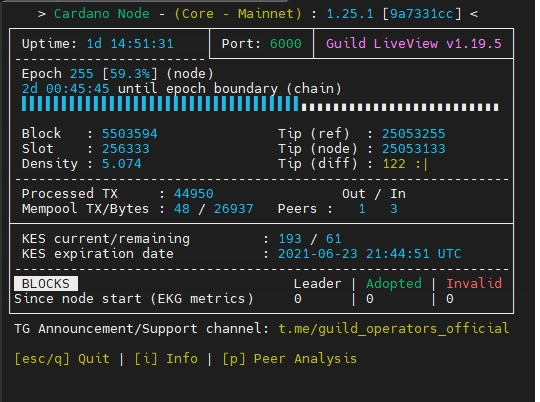Setting Up an External Passive Relay Node
This quick start guide walks through setting up an external relay node with the help of CNTOOLs.
Major credits and appreciation to the fine folks at Cardano Community Guild Operators for creating and maintaining CNtool, a most helpful swiss army knife for pool operators. You MUST be familiar with how ADA staking works and possess fundamental Linux system administration skills before continuing this guide.
🌜 Prerequisites
A different server/VM (not located on the same machine as your block-producer node)
🛸 Running the prereqs.sh Script
Installs prerequisite dependencies and creates folder structure.
sudo apt-get install curl net-toolsmkdir "$HOME/tmp";cd "$HOME/tmp"
# Install curl
# CentOS / RedHat - sudo dnf -y install curl
# Ubuntu / Debian - sudo apt -y install curl
curl -sS -o prereqs.sh https://raw.githubusercontent.com/cardano-community/guild-operators/master/scripts/cnode-helper-scripts/prereqs.sh
chmod 755 prereqs.sh
# Ensure you can run sudo commands with your user before execution
# You can check the syntax for prereqs.sh using command below:
#
# ./prereqs.sh -h
# Usage: prereqs.sh [-o] [-s] [-i] [-g] [-p]
# Install pre-requisites for building cardano node and using cntools
# -o Do *NOT* overwrite existing genesis, topology.json and topology-updater.sh files (Default: will overwrite)
# -s Skip installing OS level dependencies (Default: will check and install any missing OS level prerequisites)
# -i Interactive mode (Default: silent mode)
# -g Connect to guild network instead of public network (Default: connect to public cardano network)
# -p Copy Transitional Praos config as default instead of Combinator networks (Default: copies combinator network)
# You can use one of the options above, if you'd like to defer from defaults (below).
# Running without any parameters will run script in silent mode with OS Dependencies, and overwriting existing files.
./prereqs.shReload environment variables.
🤹♀️ Building the Cardano Node and Command Line Interface
To clone the git repository, type:
To compile binaries, type the following commands where <NodeVersion> is the node version number or branch that you want to build:
To install the compiled binaries, type:
To verify that the correct Cardano node and command line versions are installed, type:
⚒️ Using systemd Services
Using systemd services to run your Cardano nodes offers the following benefits:
Auto-start your node when the computer reboots due to maintenance, power outage, etc.
Automatically restart crashed node processes.
Maximize your stake pool up-time and performance.
Nice work. Your node is now managed by the reliability and robustness of systemd. Below are some commands for using systemd.
✅ Example systemd Commands
To confirm that the node service is active, type:
To display the status of the node service, type:
To restart the node service, type:
To stop the node service, type:
🚧 Filtering Logs
To filter logs, type:
OR
OR
🚀 Starting the Relay Node
Pro tip: 🎇 Speed this step up by copying the db folder from another node you control.
To start the relay node, type:
To install Guild LiveView, type:
To run Guild Liveview, type:
Sample output of Guild Live View

For more information, refer to the official Guild Live View docs.
🛑 Configuring and Reviewing the Relay Node Topology File
Modify the CUSTOM_PEERS section of the topologyUpdater.sh script to configure your relay node's connections to your other relays and block producer node. Refer to the official documentation for more info.
Deploy the scripts with deploy-as-systemd.sh to setup and schedule the execution. This will handle automatically sending updates to the Topology Updater API as well as fetching new peers whenever the node is restarted.
Review your topology.json and check that it looks correct. Your new relay node's topology should contain your block producer node, your other relay nodes, and other public buddy relay nodes.
🔥 Configuring Port Forwarding and/or Firewall
Specific to your networking setup or cloud provider settings, ensure your relay node's port 6000 is open and reachable.
✨ Port Forwarding Tip: Check that your relay port 6000 is open with https://www.yougetsignal.com/tools/open-ports/ or https://canyouseeme.org/ .
Additionally, if you have prometheus-node-exporter installed for providing Grafana statistics, then you need to open ports 9100 and 12798. Do not forget to update prometheus.yml on your prometheus server (aka relaynode1). Restart the prometheus service so that the new relay node appears in your dashboard.
👩💻 Configuring Topology for Existing Nodes
Finally, add your NEW relay node IP/port information to your EXISTING block producer and/or relay node's topology file. Modify the CUSTOM_PEERS section of the topologyUpdater.sh script.
For your block producer node, you'll want to manually add the new relay node information to your topology.json file.
Example snippet to add to your block producer's topology file. Add a comma to separate the nodes where appropriate.
For relay nodes, manage your topology file or modify the CUSTOM_PEERS section of the topologyUpdater.sh script.
🔄 Restarting Nodes
To refresh topology configurations for a node, you need to restart the node.
To restart nodes:
Type:
Repeat step 1 for each node having updated topology configurations.
🎊 Testing the Connection
On the Guild LiveView screen, press P to view the peer list. You should see the connection to other node's IP address.
✨ Congrats on the new relay node.
🔥 Critical Security Reminder: Relay nodes must not contain any operational certifications, vrf, skey or cold` ``` keys.
Congrats on completing the guide. ✨
Did you find our guide useful? Send us a signal with a tip and we'll keep updating it.
It really energizes us to keep creating the best crypto guides.
Use cointr.ee to find our donation addresses. 🙏
Any feedback and all pull requests much appreciated. 🌛
Hang out and chat with our stake pool community on Telegram @ https://t.me/coincashew